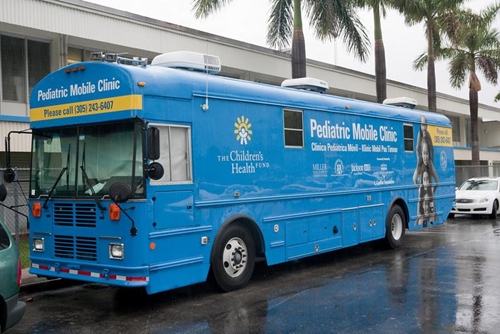Some communities in the U.S. struggle with food security and other basic necessities, which makes prioritizing healthcare difficult for public officials. Likewise, there may simply not be proper infrastructure or facilities available to deliver high-quality treatment in extremely impoverished or remote areas of the country. Other factors, like natural disasters, for example, could complicate or inhibit treatment.
In Miami-Dade County, The University of Miami Pediatric Mobile Clinic relies on AMD’s telemedicine technology to help them greatly improve access to treatment in areas that need it most.
Here are just a few of the challenges that the University of Miami set out to solve:
- Provide primary care services to over 3,000 uninsured pediatric patients each year
- Increase patient compliance rate for follow-up appointments, care plans and healthy lifestyles
- Address additional medical needs beyond primary care services including education and support.
The UMPMC was indeed able to bring treatment to individuals and families that otherwise were not getting adequate healthcare. Here are just a few of the results:
- Provided 2,000 clinical encounters and 3,000 immunizations administered
- Removed the barriers for follow-up appointments,
- Offered quick on-the-spot access to remote specialists
By bringing patients in contact with specialists and other clinical professionals, the UMPMC achieved a 90 percent patient compliance rate in follow-up appointments, up from just 30 percent prior to this initiative.
Humble origins
In 1992, the University of Miami had a unique and powerful response to the immense challenge of reaching individuals and families that had been displaced by Hurricane Andrew. In response, the Pediatric Mobile Clinic was born. Ever since, the UMPMC has been able to offer immunizations and physicals as well as urgent care or mental health support to the uninsured and disenfranchised.
The idea of a mobile health center was no unique to the University of Miami. In the late 1980’s, Dr. Irwin Redlener and singer/songwriter Paul Simon founded the New York Children’s Health Project, an effort to treat the homeless and needy. Through a donation from Simon, a mobile medical unit was used to provide pediatric care to those who otherwise could not access adequate healthcare.
The perfect partnership
With the help of AMD’s Portable TeleClinic, UMPMC is able to treat nearly 3,000 children each year. The telemedicine system allows the mobile clinic’s healthcare staff to consult with necessary physicians and medical specialists. The mobile care center a converted bus that has the clinical capacity of a traditional doctor’s office can be brought directly to neighborhoods or communities where care is needed most. Anything from primary care services and chronic disease management to dermatology and cardiac care is provided through the UMPMC.
Pediatrician Lisa Gwynn, the director of the Pediatric Mobile Clinic and associate professor of pediatrics at the University of Miami Miller School of Medicine, highlights why this program is so valuable.
“Our uninsured patients were faced with too many barriers to get to their specialist appointments because it meant they needed to travel long distances and would incur additional costs, so most of them were simply not showing up,” she said. “By bringing the remote specialists to our mobile unit via AMD’s telemedicine technology, we brought our compliance rate up significantly from 30 to 90 percent, and more importantly our patients are benefiting from all-inclusive care.”
The UMPMC is using the Portable TeleClinic system as a fully functional exam station By leveraging specialty medical devices, real-time data aggregation software and video conferencing not only can doctors reach new patients, but they are provided with the resources to improve outcomes. In the year 2014, the UMPMC completed 2,000 clinical encounters, which included nearly 200 mental health visits and administered 3,000 immunizations.
For the staff working in the mobile clinic, these telemedicine tools make it possible to work with medical professionals throughout the University of Miami and beyond. Consultation or a second opinion can be accessed with video conferencing. Likewise, examination cameras, electronic stethoscopes and a 12-lead ECG are integrated in a way that allows for sharing patient data and live medical video, all in real-time.
“Working with such an established telemedicine partner such as AMD Global Telemedicine, and leveraging their technology has allowed us to have many of the same cutting-edge services as a traditional hospital or medical practice. Through telemedicine, the UMPMC staff can easily and effectively communicate with colleagues and peers as needed,” said Dr. Gwynn.
Essential services
The UMPMC offers care to uninsured patients, and according to Dr. Gwynn, many of these individuals have never been examined by a doctor. For that reason, not only are general check-ups essential, but access to specialty care is also a critical component of their telemedicine program.
Leveraging AMD’s Portable TeleClinic and the integrated telemedicine technology has helped UMPMC extend beyond the reach of primary care to 15 specialty services offered today, including: dermatology, cardiology, endocrinology, nutrition, hematology. school physicals, management of chronic/acute illnesses, prescriptions, and many more.
Learn more about AMD’s Portable TeleClinic and the telemedicine technology that helped UMPMC deliver care.
The University of Miami Mobile Clinic was named a winning program for the Sapphire Award, presented by Florid Blue Foundation. They were honored for their outstanding program in community health care. Watch this video to learn more about UMPC program.





